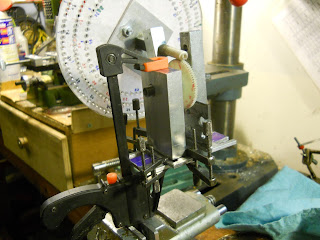Things have been very awry. My clock wheels are in trouble. Fortunately they are acrylic, or I would be out a fortune. Problem is that while some of the teeth look fine, others have flat tops. After pondering this one for a while I finally came to the conclusion that the dividing head is
running out. This means it isn't centered. It is wobbling. So let's check.
Observe my new elegant mini-dial indicator holder. It will hold both my Imperial supersensitive indicator (shown above) and a conventional DTI. It is being used to record the runout (wobble) on the wheel, which is is on a mandrel (shaft) held in a collet. These are my wonderful ER collets. They have essentially zero wobble.
'Nother shot same thing, same results. Runout about .002" or about 4 "cents" (.04mm). Uh-oh. The wheel is quite acceptable for clockwork. Time to check the runout on the shaft of the dividing head. This is quite a production. The dividing head is mounted on the mill. This, except for the base, is made of non-ferrous metal, and the indicator base will not adhere. So I had left the vise on the mill. In it I clamped a piece of angle iron, aand the dial indicator will adhere to that! So by now I had acquired a metric dial indicator, and checked the runout again. Horrors. A whole millimeter!
The runout is all in the shaft of the dividing head.
Then I took the dividing head apart and checked its shaft. It needed no dail indicator to show it was bent. So I made a new one. I used my steady rest to hold things still. Here I am, parting offf the result. I claim a new method of parting off. I use my Dremel tool holder, one of the very fragile cutoff wheels, and spin the lathe one way and the work i t'other. Got a nice clean part, and a very narrow kerf.
So the next thing was to do something about this. It is a very small dividing head, so my next idea was to add a new outboard support. It is an aluminum block. Here it is under construction.
The results on divde head 2.0 are not encouraging. I measure the runout on the new spindle:
It still comes to 30 cents. While better than a whole dollar it is not very good. Impasse. While I am figuring out what do do about this, I added a new feature to
Cecil B. de Mille. Behold my Z-axis Digital Readout.
Just a super-cheap digital plastic caliper, a bit of angle aluminum, and some drill and tap, and now I know where my Z-axis is. Of course I can always use the dials. But the Count himself (on Sesame Street) would get confused by the number of turns you made. And one turn off is a whole millimeter off. Worthwhile addition.







